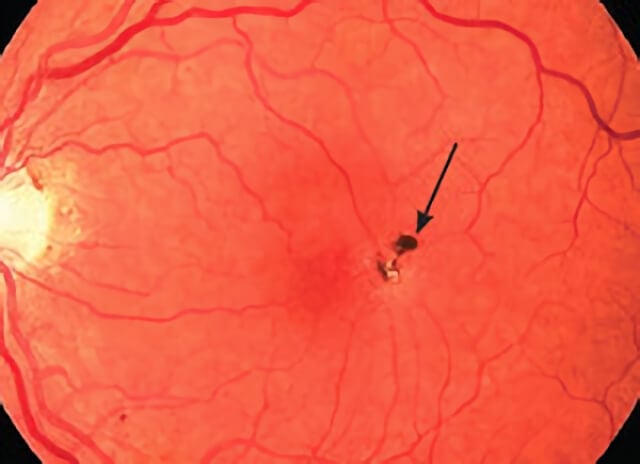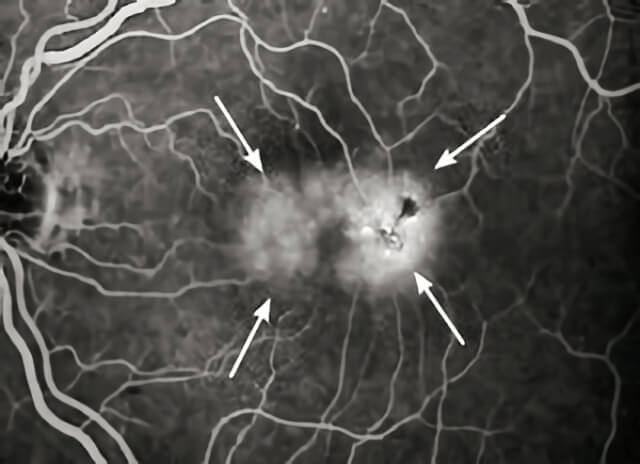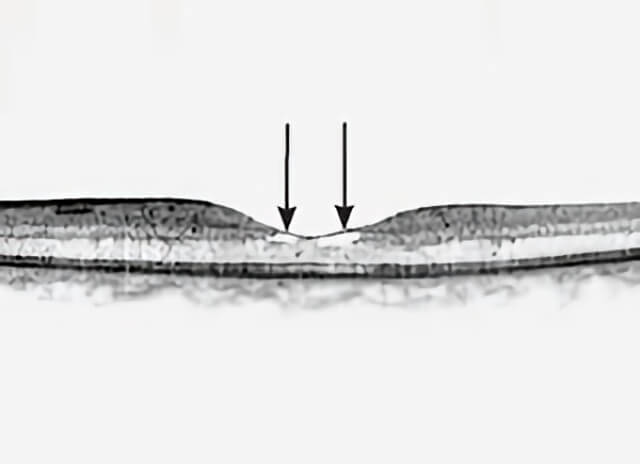Idiopathic Juxtafoveal Telangiectasis
What is idiopathic juxtafoveal telangiectasis?
Idiopathic juxtafoveal telangiectasis (IJT) is the name used to describe a group of uncommon conditions in which a person develops an abnormality in some of the blood vessels near an area called the fovea. The fovea is the small area at the center of the macula, the part of the retina that gives us our sharpest vision. In IJT the retinal blood vessels just next to the fovea become abnormally larger and twisted. These changes are similar to those seen in varicose veins, but on a tiny scale. The abnormal blood vessels can leak. When they do, they behave less like a normal garden hose and more like a “soaker” hose. This leakage causes swelling in the retina called macular edema. Over longer periods of time patients with IJT may also develop dark pigment and crystal formation in the affected parts of the retina. IJT is also sometimes called macular telangiectasia or parafoveal telangiectasis.

The abnormal vessels are near the center of the retina and in this picture there are also dark pigment clumps (arrow) characteristic of IJT.
Learn more about idiopathic juxtafoveal telangiectasis (IJT) at ASRS
What causes IJT?
The cause of IJT remains unknown. It is thought that some cases are present at birth. One theory suggests that IJT is caused by a mild backup of the blood flow in the retina that occurs over a long time. Although diabetes and high blood pressure can cause similar changes to the retinal blood vessels, IJT specifically refers to instances when neither diabetes nor high blood pressure are suspected to be the cause of the problem.

Angiogram of IJT. The grey-white cloudy leakage of dye from the abnormal vessels.
How is IJT diagnosed?
Several retinal diseases can be confused with IJT. An examination by an experienced physician is necessary to diagnose the condition. Computerized photographic tests such as a photographic assessment of the retinal blood flow after injection of an intravenous dye called a fluorescein angiogram and a computerized optical scan of the retina called an OCT can help in making the diagnosis and determining the severity of IJT. Follow up tests are often done to monitor the progression of IJT.

An OCT scan in a patient with IJT showing cysts of fluid in the retina (arrows).
How does IJT affect the vision?
Because IJT affects the retina near the fovea, people with IJT have blurred central vision in one or both eyes. It is common for the symptoms to be worse on one eye than the other. Sometimes the one eye is unaffected or so mildly affected that the person with IJT does not notice any problems in that eye. Over years, the central vision may worsen to the point where reading becomes more difficult. IJT does not affect the side vision and it does not result in total blindness.
How is IJT treated?
In many cases of IJT, no treatment is necessary. Laser is sometimes used to reduce leaking from the abnormal blood vessels in IJT. On occasion, a complication of IJT develops in which a network of new blood vessels form under the retina, causing additional leaking and bleeding. Treatment with injections of medicine in the eye or laser may be necessary. Your doctor will assess and monitor your condition and advise you about when treatment may be necessary or helpful.
Schedule Idiopathic Juxtafoveal Telangiectasis Treatment in Northern California with Retinal Consultants Medical Group
Since 1975, Retinal Consultants Medical Group has been providing outstanding care to patients throughout Northern California, including Sacramento, Modesto, and Stockton. Our retina specialists and surgeons treat multiple vitreoretinal conditions, such as age-related macular degeneration and diabetic retinopathy. We invite you to contact us with any questions or schedule an appointment today.


